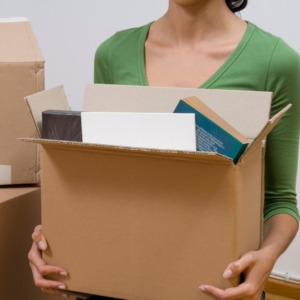Some consider books or a library collection among their home’s most prized possessions. For many, books are akin to cherished friends. It’s no fun to set up your new place and find books with torn pages, or twisted and scratched covers.
Packing and moving books cause damage if done incorrectly. Let us show you how to pack your books to arrive in the best shape possible.
Materials:
- Boxes or crates
- Packing paper
- Packing tape
- Markers
 Before You Start To Pack
Before You Start To Pack
Organize your books according to the sizes, including books, magazines, and periodicals. This will allow you to properly distribute them into cartons.
Decide which books to take
Now that you have your books in groups, assess what you need to move. If there are books that you no longer need, set them aside. Make piles for friends, neighbors, or donate to your local library or reading group. Keep in mind that some move pricing, especially for interstate moving, is weight-based. Since books are very heavy, part of your collection may not be worth moving.
Select the boxes you’ll need
Since books are very dense, book boxes can get heavy fast. Only use the smallest boxes, ideally 1.5 cubic feet, to pack books. Do not overstuff the boxes and make them too heavy to lift when moving. Aim for at most 50 pounds in each box.
Secure the boxes
Next, seal the base and sides of the box with packing tape to strengthen the package and ensures the box will not fall apart when lifted. Properly sealing boxes protects your books from damage from water or other liquids during moving.
Now you have the basics; it’s time to start to packing
- Begin unpacking the books from the bottom of the bookshelf and work your way to the top. It also helps minimize any back strain from constant bending.
- First, place some sheets of packing paper to the bottom of the moving crate.
- Start packing the heavier volumes, then the medium-sized, and finish with the lighter books at the top. Placing the light volumes at the top also helps reduce any damage from the weight of other volumes.
Here are a few methods of packing book boxes for you to consider:
Standing up Method
The standing up method of packing books is similar to how the books lie on your bookshelves. Pack the spines of the books next to the sides of the box or crate when packing. Continue stacking books spine to spine in at least two rows to start.
Cover the layers with packing paper before starting the next row. Use some newsprint or packing paper to plug any extra spaces, but not too tightly to cause friction.
Flat on the back Method
Packing books flat on their backs is an ideal way to get more books into your box and prevent pages from bending or tearing. It’s also the best way to pack books of similar sizes in one location for a snug fit. To avoid tearing or other damage, avoid placing books with their pages facing each other.
Packing precious tomes
Everybody has a set of unique books they like to keep for a lifetime. Packing costly or rare volumes will help ensure they arrive intact when moving. Wrap each book in sheets of packing paper. Fold each section to help create a buffer to minimize damage.
Continue to wrap each book and stack them inside the box or crate. Fill any open spaces with packing paper to help cushion the books during moving. Label the containers to help locate them quickly when unpacking.
 Magazines
Magazines
Magazines can lie flat at the top of your regular books as you pack to fill up any remaining spaces. Organize them according to size and let the larger volumes lie flat in the box.
Sealing & Labeling
Place a sheet of packing paper to the top of each box: close, and seal, then label. Do not over-pack the boxes. Leave enough room to help seal the box on an even plane. When you seal the boxes, try lifting them to see if you can handle the weight of moving. Ensure the base of the box can handle the pressure.
Labeling helps keep track of what’s inside to help organize the moving and unpacking at your new place. Label as you go to ensure you give specific handling instructions to protect your books from damage.
You did it, your books are packed!
Moving is always a challenge, and protecting your books is paramount. Organizing your books in groups will help you pack them in the best possible way to avoid damage. Correctly packing your books ensures they arrive in good shape and are ready to sit comfortably in their new space. If you are looking to get your books packed and packed by professionals, click here and get a free estimate.
